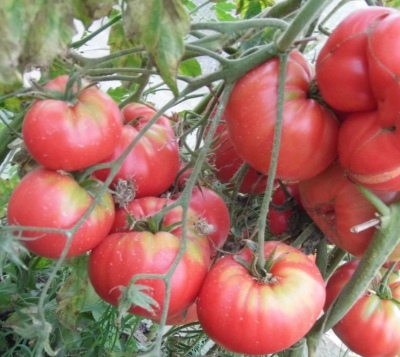
- Category: grade
- Appointment: universal
- Ripening period: mid-season
- Ripening time, days: 105-115
- Growing conditions: for open ground, for greenhouses
- Bush size: tall
- Bush height, cm: 100-200
- Ripe fruit color: Red
- Fruit shape: flat-round, slightly ribbed
- Fruit weight, g: 600-800
For those who dream of growing a tomato variety on the site, delighting with generous harvests, which will be enough for salads, and juices, and for harvesting, you should pay attention to the mid-season type of Lopatinskie tomatoes, which grows well both in the garden and in the film greenhouse.
Breeding history
Lopatinsky tomatoes are a striking representative of amateur selection. Despite the fact that the culture has not yet been entered into Rosreestr, it is in high demand among farmers and gardeners. Recommended for growing tomato in all climatic zones, as it grows well in the open field, and in temporarily equipped greenhouses, and in greenhouses.
Description of the variety
The Lopatinskie plant is a tall shrub of an indeterminate type, growing in height from 100 to 200 cm. Tomato bushes are characterized by a strong thickening of large foliage of a rich green color, powerful stems, long, spreading branches resembling vines, a developed root system and a simple type of inflorescence. On healthy bushes, 6-7 fruit clusters are formed with 4-5 ovaries in each.
Growing a vegetable crop, farmers recommend forming a bush of 2-3 stems, it is imperative to tie up the plant, otherwise the stems and branches will be deformed and lie on the ground under the weight of tomatoes, and also remove unnecessary stepsons in a timely manner.
The main qualities of the fruit
The Lopatinsky tomato represents a class of large-fruited nightshade crops. On average, the weight of the berry is 600-800 grams. In a state of full ripeness, the tomato is evenly covered with a rich red color. In an unripe form, the tomato is light green in color. The shape of the berry is flat-rounded with slightly noticeable ribbing. Due to the moderately dense and elastic skin, tomatoes do not crack, they tolerate transportation well without losing marketability and are stored for a long time. The variety has a universal purpose, therefore it is eaten with pleasure fresh, in blanks, processed for dressings, drinks, sauces.
Taste characteristics
Excellent taste is one of the advantages of the variety. There is a pronounced sweetness in the taste, complemented by a fruity aroma. The pulp of the tomato is fleshy, firm and very juicy. A large number of seeds and white veins in the pulp are not observed.
Ripening and fruiting
The ripening period of the culture is average. From full shoots to ripe berries, 105-115 days pass on the bush. Fruiting in the variety is very stretched - you can remove tomatoes from mid-summer to early autumn. The active ripening phase occurs in July-August. Tomatoes are grown gradually.
Yield
The yield indicators of this species are impressive. Observing the elementary rules of agricultural technology, from 1 m2 per season you can get up to 10 kg of fragrant and juicy berries.
The timing of planting seedlings and planting in the ground
The plant is planted in seedlings. Sowing seeds for seedlings is carried out 50-60 days before transferring to a new place. The ideal time is mid-March. The seed is pre-sorted, disinfected and treated with a growth stimulant. The seeds are buried in the soil by 2 cm.The greenhouse effect provided by glass or polyethylene covering the box will help accelerate germination. The plant grows well with sufficient illumination and room temperature + 15 ... 18 degrees. At the stage of appearance of 2-3 leaves on the bush, a dive is carried out. A week before transplanting, the bushes should be tempered a little so that adaptation to new conditions is stress-free.
Planting in open ground or in a greenhouse is carried out from mid-May to early June, under appropriate weather conditions.

Growing tomato seedlings is an extremely important process, because it largely depends on whether the gardener can harvest at all. All aspects must be taken into account, from seedbed preparation to planting in the ground.
Landing scheme
When growing a crop, it is worth adhering to the rules of planting density. Up to 4 seedling bushes can be placed on 1 m2. The correct scheme for landing is considered to be a 50x40 cm scheme.

Growing and caring
This variety is completely unpretentious to the soil, but requires the implementation of basic agrotechnical rules. The best soil will be one that is free of grass and debris, loose and fertile.
As for care, it consists of: watering, applying top dressing, loosening and mulching the soil, forming and tying bushes, regular pinching, as well as preventing viruses.




A plant needs different micronutrients at each stage of growth. All fertilizers can be divided into two groups: mineral and organic. Folk remedies are often used: iodine, yeast, bird droppings, eggshells.
It is important to observe the rate and period of feeding. This also applies to folk remedies and organic fertilizers.
Disease and pest resistance
The vegetable crop has developed immunity to late blight, despite prolonged fruiting, as well as to many tomato diseases - tobacco mosaic, fusarium wilting. Weak protection of the plant against the invasion of pests, therefore, it is necessary to spray with special preparations.


Resistant to adverse weather conditions
Tomato Lopatinskie is hardy to adverse weather conditions, therefore it perfectly tolerates temperature jumps, prolonged heat. In addition, it is not afraid of short periods of drought. Only a draft and a gusty wind are undesirable for the plant.

























































































